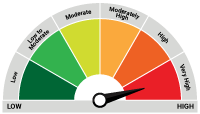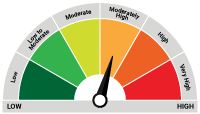Taking the Bumpy Road Home: Understanding Investment Risks
Posted On Wednesday, Sep 09, 2015
All rides back to home or for that matter any destination can be smooth, but in all likelihood it will have bumps. Depending on the road taken, the impact of these bumps could be severe or if managed well, it could be relatively smooth. These “bumps” are there in the field of investments too... and are called “risks”.
After a period of focusing on returns, returns and more returns, the focus is back on risks. Investors have different tolerance for risks, and therefore every investor addresses the risks differently.
Risk is perceived differently by investors, and there are a few popular concepts around risks.
| • | Risk is permanent loss of investment. The investment goes to zero. An investor who makes direct investments in stocks, could face a risk of this first kind. |
| • | Risk could also mean the volatility in returns. If the returns are volatile, then it is possible that the asset prices and therefore the returns could be low, just at the time when the investor had planned to withdraw the money. |
| • | Risk of permanent loss of investment can be reduced by thorough research and careful selection of the assets to invest in. |
| • | Volatility risk can be reduced by diversification into different asset classes. It can also be reduced by adopting different strategies within the same asset class. For example; in equities, the investor may diversify between funds that invest in large companies and mid-sized companies. In the case of real estate- investing in different cities or between commercial and residential properties may help in reducing the risk. |
| • | Risk is never completely eliminated, it only gets re-arranged…and the impact of risk can be reduced. |
| • | Higher the risk higher the returns, means that the investor should demand higher returns for the risk taken. In the case of volatile returns- higher risk means opportunities to make higher returns; for example if the markets are volatile then the investor can enhance his return by investing additional amounts when the returns and asset prices are down. |
In the game of cricket, risk to the batsman arises when his eye moves away from the ball. Similarly risk arises when the investor focuses on headline news and takes his eye away from the fundamentals.
Currently, the media is focused on events in China and the possibility of increasing interest rates in US. This has made the investor nervous. But, beneath this sensational news, are the slowly improving fundamentals in India:
| • | The declining commodity prices will benefit consumers, the country and companies. |
| • | The foreign currency reserves built up by RBI means our currency could be stable. Since India imports oil and other goods, a stable currency will be beneficial. |
| • | Domestic inflation is more benign. |
| • | The slow but steady correction in real estate prices in some cities is positive as it unlocks a logjam of higher prices but no sales. The more the number of houses that genuine buyers are able to buy, the better would be the demand for other consumer products such as white goods. |
The only headwind appears to be the poor monsoon and its impact in rural economy.
Therefore declining equity prices should not make investors nervous; instead it could be used as an opportunity to enhance returns by making some additional investments during the time when prices are falling.
To give you a sense of volatility in different asset classes, here are three of our products with different volatility and return.
Note: Volatility is captured by standard deviation. Standard deviation of a fund tells how much a fund’s return has varied from its average return.
To understand this better, consider an example: A and B study mathematics together, listed below are their examination scores:
| Student A | Student B | |
| Test 1 | 35 | 60 |
| Test 2 | 75 | 55 |
| Test 3 | 30 | 70 |
If you take a look at both their performances, though A has outperformed B in the second test, B seems to be a more consistent student.
With respect to mutual funds, if the NAV of the fund moves up and down rapidly over short time periods, it has high volatility. If the NAV almost never changes, it has low volatility. Generally more volatile a fund, higher is the investment risk.
The Quantum Multi Asset Fund (QMAF) has the lowest standard deviation, then it is Quantum Long Term Equity Fund (QLTEF) and then it is Quantum Equity Fund of Funds (QEFOF).
Since the QMAF has diversified into three different asset classes the volatility is lowest. QEFOF on the other is a fund that is exposed to different funds whose underlying is all equities. Since this strategy may have exposure to small and mid-cap companies, the volatility is higher than QLTEF.
The returns in any year can be very different between the three funds.
Depending on the risk appetite, the investor can choose among the three funds or a combination of them in different proportions to reduce the volatility and at the same have a good return. For instance, in the last one year QLTEF has underperformed its peers largely because it follows a certain philosophy and therefore sold equities and held cash when the markets were still going up. This hurt its performance. On the other hand the Fund of Funds is exposed to different styles of fund management which could include growth oriented funds.
These funds did well in the last one year, hence the returns of QEFOF was better than QLTEF. Note that QEFOF does not hold QLTEF as one of its underlying funds; this is as per its investment strategy, which helps us keep conflicts of interest at bay.
Performance of Quantum Long Term Equity Fund
| Period | Scheme (%) | Benchmark (%)# | Additional Benchmark (%)## | Value of Investment of Rs 10,000@ | ||
| Scheme (Rs) | Benchmark (Rs)# | Additional Benchmark (Rs)## | ||||
| June 30, 2014 to June 30, 2015 | 9.74 | 10.96 | 9.31 | 10,974 | 11,096 | 10,931 |
| June 28, 2013 to June30, 2014 | 44.50 | 32.87 | 31.03 | 14,450 | 13,287 | 13,103 |
| June 29, 2012 to June28, 2013 | 9.76 | 13.15 | 11.28 | 10,976 | 11,315 | 11,128 |
| Since Inception ** | 15.59 | 12.31 | 10.68 | 38,520 | 29,456 | 25,714 |
^ Past performance may or may not be sustained in the future. Load is not taken into consideration and Returns are for Growth Options.
Returns up to 1 year period are Absolute Returns. Returns greater than 1 year period are compounded annualized (CAGR). #S&P BSE 30 TRI ## S&P BSE Sensex @shows the current value of Rs 10,000/- invested at the beginning of a given period. Standard deviation: 19.12%. **Inception Date: March 13, 2006. Since inception returns are calculated on NAV of Rs. 10 invested at inception.
Atul Kumar, fund manager of Quantum Long Term Equity Fund, also manages Quantum Tax Saving Fund. Please click here to view the performance of these schemes.
Performance of Quantum Equity Fund of Funds
| Period | Scheme (%) | Benchmark (%)# | Additional Benchmark (%)## | Value of Investment of Rs 10,000@ | ||
| Scheme (Rs) | Benchmark (Rs)# | Additional Benchmark (Rs)## | ||||
| June 30, 2014 to June 30, 2015 | 17.57 | 12.01 | 9.31 | 11,757 | 11,201 | 10,931 |
| June 28, 2013 to June 30, 2014 | 49.63 | 34.45 | 31.03 | 14,963 | 13,445 | 13,103 |
| June 29, 2012 to June 28, 2013 | 6.85 | 8.69 | 11.28 | 10,685 | 10,869 | 11,128 |
| Since Inception ** | 16.53 | 11.32 | 10.68 | 24,852 | 18,931 | 18,288 |
^ Past performance may or may not be sustained in the future. Load is not taken into consideration and Returns are for Growth Option.
Returns up to 1 year period are Absolute Returns. Returns greater than 1 year period are compounded annualized (CAGR). #S&P BSE 200 INDEX ## S&P BSE Sensex @shows the current value of Rs 10,000/- invested at the beginning of a given period. Standard deviation: 14.96%. **Inception Date: July 20, 2009. Since inception returns are calculated on NAV of Rs. 10 invested at inception.
Chirag Mehta, fund manager of Quantum Equity Fund of Funds also manages Quantum Gold Fund, Quantum Gold Savings Fund and Quantum Multi Asset Fund. Please click here to view the performance of these schemes.
Performance of Quantum Multi Asset Fund
| Period | Scheme (%) | Benchmark (%)# | Value of Investment of Rs 10,000@ | |
| Scheme (Rs) | Benchmark (Rs)# | |||
| June 30, 2014 to June 30, 2015 | 7.54 | 8.64 | 10,754 | 10,864 |
| June 28, 2013 to June 30, 2014 | 20.58 | 17.57 | 12,058 | 11,757 |
| Since Inception ** | 11.09 | 10.90 | 13,671 | 13,601 |
^ Past performance may or may not be sustained in the future. Load is not taken into consideration and Returns are for Growth Option. Returns up to 1 year period are Absolute Returns. Returns greater than 1 year period are compounded annualized (CAGR). #Crisil Composite Bond Fund Index (40%)+S&P BSE Sensex Total Return Index (40%)+Domestic Price Of Gold (20%). @shows the current value of Rs 10,000/- invested at the beginning of a given period Standard deviation: 5.22% * * Inception Date: July 11, 2012. Since inception returns are calculated on NAV of Rs. 10 invested at inception.
Chirag Mehta, fund manager of Quantum Multi Asset Fund also manages Quantum Gold Fund, Quantum Gold Savings Fund and Quantum Equity Fund of Funds. Please click here to view the performance of these schemes.
In conclusion, by choosing the best road (QLTEF, QEFOF, QMAF or a combination of these) that suits the investor’s risk appetite, the destination can be reached with lesser adverse impact of the bumps. And, it goes without saying that to get home, it is important for an investor to stay on the road until the end, and not let the bumps upset or detail them!
Product Labeling
| Name of the Scheme & Primary Benchmark | This product is suitable for investors who are seeking* | Risk-o-meter of Scheme |
| Quantum Long Term Equity Value Fund An Open Ended Equity Scheme following a Value Investment Strategy | • Long term capital appreciation • Invests primarily in equity and equity related securities of companies in S&P BSE 200 index. |  Investors understand that their principal will be at Moderate Risk |
| Quantum Equity Fund of Funds An Open Ended Fund of Funds scheme Investing in Open Ended Diversified Equity Schemes of Mutual Funds | • Long term capital appreciation • Investments in portfolio of open-ended diversified equity schemes of mutual funds registered with SEBI whose underlying investments are in equity and equity related securities of diversified companies |  Investors understand that their principal will be at Very High Risk |
| Quantum Multi Asset Fund of Funds (An Open Ended Fund of Funds Scheme Investing in schemes of Quantum Mutual Fund) | • Long term capital appreciation and current income • Investments in portfolio of schemes of Quantum Mutual Fund whose underlying investments are in equity , debt / money market instruments and gold |  Investors understand that their principal will be at Moderately High Risk< |
* Investors should consult their financial advisers if in doubt about whether the product is suitable for them.
Disclaimer, Statutory Details & Risk Factors:
The views expressed here in this article / video are for general information and reading purpose only and do not constitute any guidelines and recommendations on any course of action to be followed by the reader. Quantum AMC / Quantum Mutual Fund is not guaranteeing / offering / communicating any indicative yield on investments made in the scheme(s). The views are not meant to serve as a professional guide / investment advice / intended to be an offer or solicitation for the purchase or sale of any financial product or instrument or mutual fund units for the reader. The article has been prepared on the basis of publicly available information, internally developed data and other sources believed to be reliable. Whilst no action has been solicited based upon the information provided herein, due care has been taken to ensure that the facts are accurate and views given are fair and reasonable as on date. Readers of this article should rely on information/data arising out of their own investigations and advised to seek independent professional advice and arrive at an informed decision before making any investments. Please visit – www.quantumamc.com/disclaimer to read scheme specific risk factors.
Related Posts
-

Equity Monthly for January 2026
Posted On Friday, Jan 02, 2026
Indian markets remained range-bound in 2025
Read More -

Gold Monthly for January 2026
Posted On Thursday, Jan 01, 2026
Gold Market Review and Outlook: 2025–2026
Read More -

Debt Monthly for January 2026
Posted On Thursday, Jan 01, 2026
Navigating 2026: India’s Bond Market in a Changing Global Landscape
Read More



